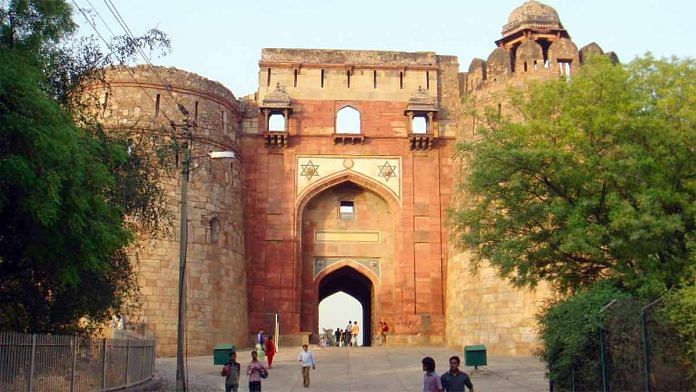New Delhi: The Archaeological Survey of India (ASI) is set to launch an excavation at Delhi’s Purana Quila just over a year after another expedition at the 16th-century fort was wrapped up.
The objective of the latest excavation is unclear, but an ASI official said the purpose was to “carry forward research from the previous excavation”, whose objectives included finding a link between the Purana Quila and the epic Mahabharata.
Even so, insiders described a second excavation in such quick succession as “unusual”.
The Purana Quila’s supposed association with the mythical city of Indraprastha — the capital of the Pandavas and the Kauravas — from the Mahabharata has long fascinated the ASI.
The previous expedition, which ended in early 2018, was led by archaeologist Vasant Swarnkar, and failed to establish the site’s association with the Mahabharata.
The new project is scheduled to begin within a month-and-a-half, led by superintendent archaeologist B.R. Singh, who is due to retire in two to three months.
The fact that a different archaeologist, and one who will retire much before the project is likely to be completed, will lead the fresh excavation has also left insiders puzzled.
“Normally, the previous leadership carries the excavation forward, since they are familiar with the terrain,” said a second senior ASI member, adding that an excavation of this kind would require a commitment of at least six months to a year.
V.N. Prabhakar, the director of ASI’s Institute of Archaeology, Exploration & Excavation, will oversee the project along with Singh.
ThePrint made repeated attempts to reach Singh and Prabhakar for comment, but there was no response.
Also Read: India’s top 5 revenue generating monuments were all built by Muslim rulers
‘Reading the legend too literally’
In September, a consolidated report on the findings from the 2017-18 excavation, and another in 2013-2014, was submitted to the ASI.
On 25 October, a committee comprising members from the ASI and the Ministry of Culture decided to reopen the site for excavation along with eight others, including a dried-up river bed along the Rajasthan-Haryana border where the fabled Saraswati was believed to flow.
Excavations at the site so far have aimed to discover a stratified layer of what is called ‘painted grey ware’ (PGW), a soil culture from the pre-Mauryan period of the Iron Age, which started around 800 BCE.
A stratified layer is an archeological term for a “habitational deposit”, found as a section or a layer in the ground. Studying the different strata or layers in a given area helps archaeologists establish a timeline for a certain area, including the civilisations it may have hosted.
According to Encyclopaedia Britannica, “An important principle in the application of stratigraphy to archaeology is the law of superposition — the principle that in any undisturbed deposit the oldest layers are normally located at the lowest level.”
B.B. Lal, the first archaeologist to excavate the fort, was also the first to link his findings of the culture with the Mahabharata. Deposits of the culture were first discovered in the fort between 1969 and 1973, when Lal dug the fort for the second time.
The link between PGW and Mahabharata was made in the 1950s, at a time when the ASI was unearthing several sites mentioned in the epic.
Lal first discovered the deposits in Hastinapura, located in Meerut, in 1951, and estimated the culture fell between the 1000-500 BCE bracket. Determined to unearth the legendary city of Indraprastha, Lal excavated the fort in 1954 and 1955, and found traces of the deposit in 1973.
Even though PGW deposits were commonly found at the lowest level among sites mentioned in the Mahabharata, archaeologists have never been able to find it in a stratified form, which could confirm the association between the two.
It is the search for this layer, which could both predate the fort and strengthen its association to legend, that draws the ASI to the Purana Quila time and again.
“If a stratified layer is found, it would establish an association between the site and the period of the Mahabharata. The possibility that the fort lies on the ruins of Indraprastha becomes more plausible,” said a retired ASI member.
“When I excavated the Purana Quila in 2013-14 and 2017-18, I was not able to establish a PGW stratified layer, but what I was able to establish was its multi-cultural nature — it’s a remarkable site because it’s been continuously occupied for 2,500 years,” Swarnkar told ThePrint.
“My research found that it could even date back to the pre-Mauryan era, around 4th-5th century BCE,” he said.
The ASI’s website concedes that the quila is “perhaps the site of Indraprastha” — but associating the PGW with the epic is to read the legend “too literally”, said historian Upinder Singh.
“It’s possible that there’s a historical basis to the epics, but you’re not likely to find that kind of proof,” Singh added. “Even if PGW is found in stratified form, it only tells us that it’s an older site than we thought. It doesn’t tell us it was the site of Indraprastha.”
Archaeologist Supriya Varma agreed. “It is often difficult to co-relate literary or religious texts and epics with archaeological data as the two deal with very different issues pertaining to the past,” she said.
“Nothing links PGW to the Mahabharata except that it is found in some places that are mentioned in this epic,” she added.
Also Read: Scheme for private players to ‘adopt’ monuments goes full steam, with critics & ASI in tow




I belief in the existence of indraprastha
I’m a student of class 10 and I’m doing reasearch about purana quila and lakshagraha which was situated at up district bagpat –Barnava ….if any of u interested on my topics please inform me through email ..
looks like an attempt to “fabricate history”
Have very fond memories of Purana Quila. Throughout my late teens and early youth was a regular visitor. And it still gets my juices flowing.